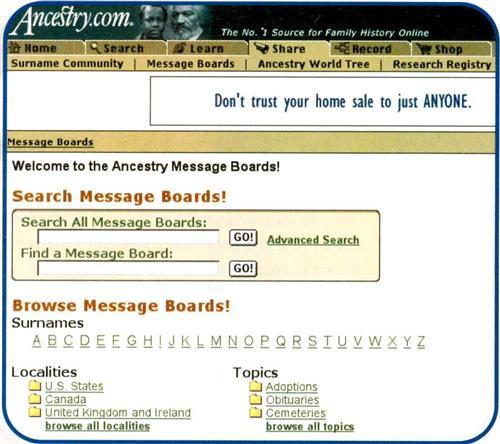Sign up for the Family Tree Newsletter Plus, you’ll receive our 10 Essential Genealogy Research Forms PDF as a special thank you!
Get Your Free Genealogy Forms
"*" indicates required fields

If you used the old boards but were frustrated by their less-than-user-friendly interface, it’s time you went back and searched again. The new message boards have a cleaner appearance, use slick search technology and are a breeze to navigate. The more than 100,000 boards are divided into surname, locality and research topics.
Although you’ll probably jump right into a message search, don’t miss out on some built-in extras that can reduce your research time. For example, you can add any board to My Notifications if you want to receive an e-mail when a new message is posted. This means you don’t have to return to the site time and again in hopes of finding a new posting about your surname. You can also add any board to My Favorites, which is a list of quick links to your most frequently visited forums.
Another unique feature of the system is its “gateway” to mailing lists. Some (but not all) of the message boards are set up so that every posted message is automatically added to a mailing list of the same topic. This is great news for researchers because it increases the number of people who will see your message. You’ll know which boards have gatewayed messages by the notice posted at the top of the board.
Although anyone can post or read all the messages, only registered users can access the My Notification and My Favorites features. If you’re a MyFamily.com user, you use the same ID and password as your MyFamily Web site. Otherwise, register (it’s free) by choosing a user name and password, and providing your name and e-mail address.
One of the handiest features of the new system is the on-site search engine. Use it to wade through millions of messages to locate other family researchers or ferret out clues for further investigation. You can confine your search to any one board — such as one for your surname — or broaden it to search the entire system. If your surname has several variant spellings, use the Advanced Search option to search by Soundex (a phonetically based spelling system; see <www.familytreemagazine.com/soundex. html>).
Although your first searches will probably be by surname, be sure to give the locality boards a spin, too. They’re divided by geographic area, with the United States divided by county. If your ancestor lived in a small town, there’s a good chance of finding a posting about them, their in-laws or neighbors on one of the county boards.
Topic boards can also be a great help if you’re just getting started or jumping into a new branch of research, such as immigration or military records. These forums contain messages ranging from questions about Revolutionary War pay vouchers to opinions about genealogy software products.
To leave a message of your own, click the Post a New Message link. If you don’t want to keep checking the Web site for replies, choose the “Send me an e-mail when anyone replies to this message” option. You can respond to any message to clicking the Post Reply link. Be polite in your postings, as other users can report abuses such as obscenities, spam or personal attacks.
Message boards are one of the quickest ways to network with other family researchers. With the tens of thousands of boards at Ancestry-Roots Web, you’re sure to find the one that could open up even your most perplexing dead end.
From the April 2002 issue of Family Tree Magazine
ADVERTISEMENT
